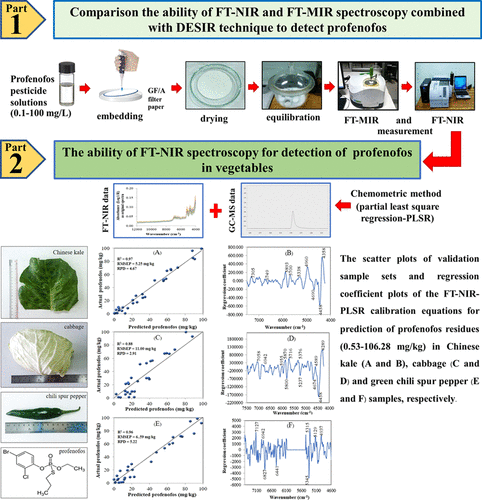Our official English website, www.x-mol.net, welcomes your
feedback! (Note: you will need to create a separate account there.)
Detection of Profenofos in Chinese Kale, Cabbage, and Chili Spur Pepper Using Fourier Transform Near-Infrared and Fourier Transform Mid-Infrared Spectroscopies
ACS Omega ( IF 3.7 ) Pub Date : 2021-09-23 , DOI: 10.1021/acsomega.1c03674 Atchara Sankom 1, 2 , Warapa Mahakarnchanakul 1, 2 , Ronnarit Rittiron 3 , Tanaboon Sajjaanantakul 1 , Thammasak Thongket 4
ACS Omega ( IF 3.7 ) Pub Date : 2021-09-23 , DOI: 10.1021/acsomega.1c03674 Atchara Sankom 1, 2 , Warapa Mahakarnchanakul 1, 2 , Ronnarit Rittiron 3 , Tanaboon Sajjaanantakul 1 , Thammasak Thongket 4
Affiliation

|
Different types of quantitative technology based on infrared spectroscopy to detect profenofos were compared based on Fourier transform near-infrared (FT-NIR; 12,500–4000 cm–1) and Fourier transform mid-infrared (FT-MIR; 4000–400 cm–1) spectroscopies. Standard solutions in the range of 0.1–100 mg/L combined with the dry-extract system for infrared (DESIR) technique were analyzed. Based on partial least-squares regression (PLSR) to develop a calibration equation, FT-NIR–PLSR produced the best prediction of profenofos residues based on the values for R2 (0.87), standard error of prediction or SEP (11.68 mg/L), root-mean-square error of prediction or RMSEP (11.50 mg/L), bias (−0.81 mg/L), and ratio performance to deviation or RPD (2.81). In addition, FT-MIR–PLSR produced the best prediction of profenofos residues based on the values for R2 (0.83), SEP (13.10 mg/L), RMSEP (13.00 mg/L), bias (1.46 mg/L), and RPD (2.49). Based on the ease of use and appropriate sample preparation, FT-NIR–PLSR combined with DESIR was chosen to detect profenofos in Chinese kale, cabbage, and chili spur pepper at concentrations of 0.53–106.28 mg/kg. The quick, easy, cheap, effective, rugged, and safe technique coupled with gas chromatography–mass spectrometry was used to obtain the actual values. The best FT-NIR–PLSR equation provided good profenofos detection in all vegetables based on values for R2 (0.88–0.97), SEP (5.27–11.07 mg/kg), RMSEP (5.25–11.00 mg/kg), bias (−1.39 to 1.30 mg/kg), and RPD (2.91–5.22). These statistics revealed no significant differences between the FT-NIR predicted values and actual values at a confidence interval of 95%, with agreeable results presented at pesticide residue levels over 30 mg/kg. FT-NIR spectroscopy combined with DESIR and PLSR should be considered as a promising screening method for pesticide detection in vegetables.
中文翻译:

使用傅里叶变换近红外和傅里叶变换中红外光谱法检测大白菜、卷心菜和辣椒中的 Profenofos
基于傅立叶变换近红外 (FT-NIR; 12,500–4000 cm –1 ) 和傅立叶变换中红外 (FT-MIR; 4000–400 cm –1 ) 光谱。分析了 0.1–100 mg/L 范围内的标准溶液,并结合红外干提取系统 (DESIR) 技术进行了分析。基于偏最小二乘回归 (PLSR) 来开发校准方程,FT-NIR-PLSR 基于R 2的值产生了对 profenofos 残留的最佳预测(0.87)、预测或 SEP 的标准误差 (11.68 mg/L)、预测或 RMSEP 的均方根误差 (11.50 mg/L)、偏差 (-0.81 mg/L) 以及与偏差或 RPD 的比率性能(2.81)。此外,FT-MIR-PLSR 基于R 2(0.83)、SEP (13.10 mg/L)、RMSEP (13.00 mg/L)、偏差 (1.46 mg/L) 和 RPD (2.49)。基于易于使用和适当的样品制备,选择 FT-NIR-PLSR 结合 DESIR 检测大白菜、卷心菜和辣椒中浓度为 0.53–106.28 mg/kg 的丙磺诺磷。使用快速、简单、廉价、有效、坚固且安全的技术与气相色谱-质谱联用来获得实际值。基于R 2 的值,最佳 FT-NIR-PLSR 方程在所有蔬菜中提供了良好的 profenofos 检测(0.88–0.97)、SEP (5.27–11.07 mg/kg)、RMSEP (5.25–11.00 mg/kg)、偏差 (-1.39 到 1.30 mg/kg) 和 RPD (2.91–5.22)。这些统计数据显示 FT-NIR 预测值与实际值之间没有显着差异,置信区间为 95%,当农药残留水平超过 30 mg/kg 时,结果令人满意。FT-NIR 光谱结合 DESIR 和 PLSR 应被视为一种很有前途的蔬菜农药检测筛选方法。
更新日期:2021-10-12
中文翻译:

使用傅里叶变换近红外和傅里叶变换中红外光谱法检测大白菜、卷心菜和辣椒中的 Profenofos
基于傅立叶变换近红外 (FT-NIR; 12,500–4000 cm –1 ) 和傅立叶变换中红外 (FT-MIR; 4000–400 cm –1 ) 光谱。分析了 0.1–100 mg/L 范围内的标准溶液,并结合红外干提取系统 (DESIR) 技术进行了分析。基于偏最小二乘回归 (PLSR) 来开发校准方程,FT-NIR-PLSR 基于R 2的值产生了对 profenofos 残留的最佳预测(0.87)、预测或 SEP 的标准误差 (11.68 mg/L)、预测或 RMSEP 的均方根误差 (11.50 mg/L)、偏差 (-0.81 mg/L) 以及与偏差或 RPD 的比率性能(2.81)。此外,FT-MIR-PLSR 基于R 2(0.83)、SEP (13.10 mg/L)、RMSEP (13.00 mg/L)、偏差 (1.46 mg/L) 和 RPD (2.49)。基于易于使用和适当的样品制备,选择 FT-NIR-PLSR 结合 DESIR 检测大白菜、卷心菜和辣椒中浓度为 0.53–106.28 mg/kg 的丙磺诺磷。使用快速、简单、廉价、有效、坚固且安全的技术与气相色谱-质谱联用来获得实际值。基于R 2 的值,最佳 FT-NIR-PLSR 方程在所有蔬菜中提供了良好的 profenofos 检测(0.88–0.97)、SEP (5.27–11.07 mg/kg)、RMSEP (5.25–11.00 mg/kg)、偏差 (-1.39 到 1.30 mg/kg) 和 RPD (2.91–5.22)。这些统计数据显示 FT-NIR 预测值与实际值之间没有显着差异,置信区间为 95%,当农药残留水平超过 30 mg/kg 时,结果令人满意。FT-NIR 光谱结合 DESIR 和 PLSR 应被视为一种很有前途的蔬菜农药检测筛选方法。









































 京公网安备 11010802027423号
京公网安备 11010802027423号